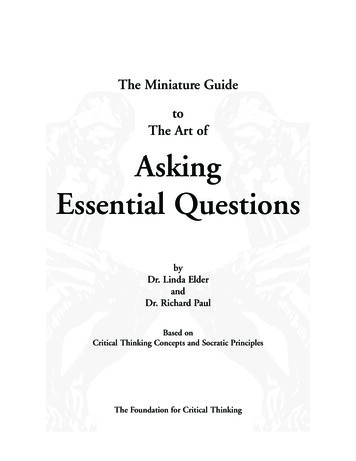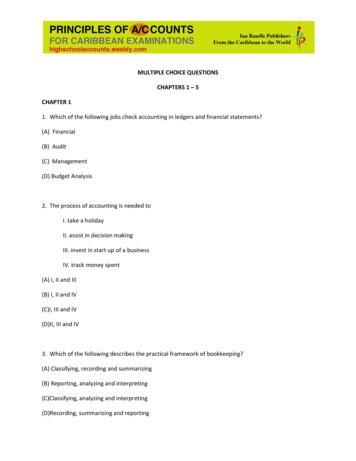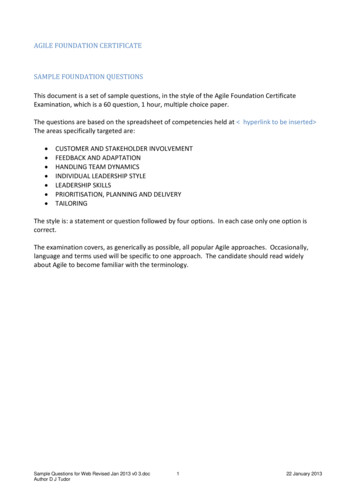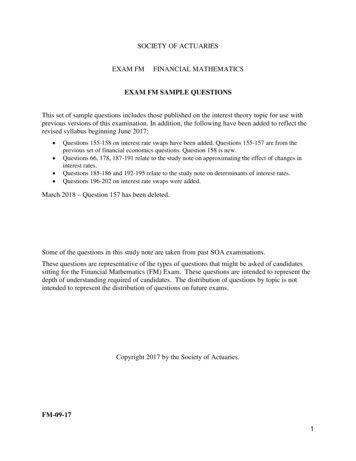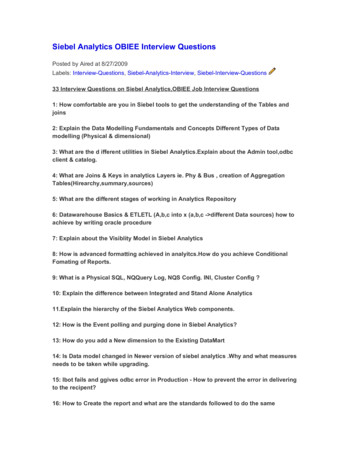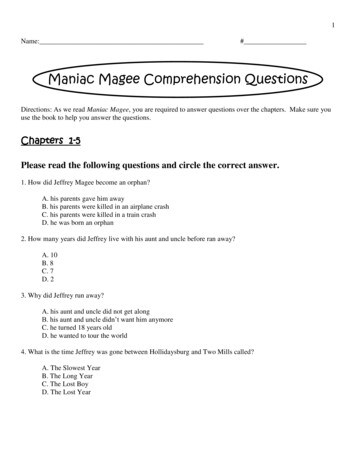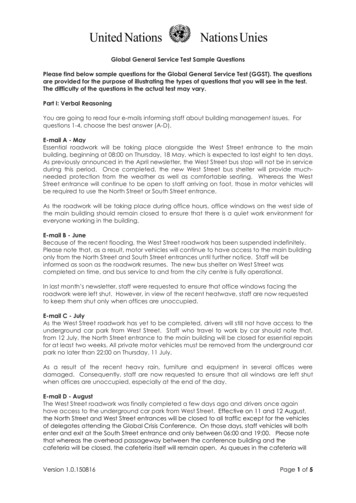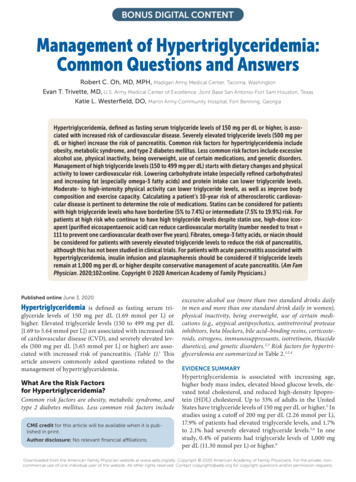
Transcription
BONUS DIGITAL CONTENTManagement of Hypertriglyceridemia: Common Questions and AnswersRobert C. Oh, MD, MPH, Madigan Army Medical Center, Tacoma, WashingtonEvan T. Trivette, MD, U.S. Army Medical Center of Excellence, Joint Base San Antonio-Fort Sam Houston, TexasKatie L. Westerfield, DO, Martin Army Community Hospital, Fort Benning, GeorgiaHypertriglyceridemia, defined as fasting serum triglyceride levels of 150 mg per dL or higher, is associated with increased risk of cardiovascular disease. Severely elevated triglyceride levels (500 mg perdL or higher) increase the risk of pancreatitis. Common risk factors for hypertriglyceridemia includeobesity, metabolic syndrome, and type 2 diabetes mellitus. Less common risk factors include excessivealcohol use, physical inactivity, being overweight, use of certain medications, and genetic disorders.Management of high triglyceride levels (150 to 499 mg per dL) starts with dietary changes and physicalactivity to lower cardiovascular risk. Lowering carbohydrate intake (especially refined carbohydrates)and increasing fat (especially omega-3 fatty acids) and protein intake can lower triglyceride levels.Moderate- to high-intensity physical activity can lower triglyceride levels, as well as improve bodycomposition and exercise capacity. Calculating a patient’s 10-year risk of atherosclerotic cardiovascular disease is pertinent to determine the role of medications. Statins can be considered for patientswith high triglyceride levels who have borderline (5% to 7.4%) or intermediate (7.5% to 19.9%) risk. Forpatients at high risk who continue to have high triglyceride levels despite statin use, high-dose icosapent (purified eicosapentaenoic acid) can reduce cardiovascular mortality (number needed to treat 111 to prevent one cardiovascular death over five years). Fibrates, omega-3 fatty acids, or niacin shouldbe considered for patients with severely elevated triglyceride levels to reduce the risk of pancreatitis,although this has not been studied in clinical trials. For patients with acute pancreatitis associated withhypertriglyceridemia, insulin infusion and plasmapheresis should be considered if triglyceride levelsremain at 1,000 mg per dL or higher despite conservative management of acute pancreatitis. (Am FamPhysician. 2020;102:online. Copyright 2020 American Academy of Family Physicians.)Published online June 3, 2020excessive alcohol use (more than two standard drinks dailyHypertriglyceridemia is defined as fasting serum tri- in men and more than one standard drink daily in women),glyceride levels of 150 mg per dL (1.69 mmol per L) orhigher. Elevated triglyceride levels (150 to 499 mg per dL[1.69 to 5.64 mmol per L]) are associated with increased riskof cardiovascular disease (CVD), and severely elevated levels (500 mg per dL [5.65 mmol per L] or higher) are associated with increased risk of pancreatitis. (Table 1).1 Thisarticle answers commonly asked questions related to themanagement of hypertriglyceridemia.What Are the Risk Factorsfor Hypertriglyceridemia?Common risk factors are obesity, metabolic syndrome, andtype 2 diabetes mellitus. Less common risk factors includeCME credit for this article will be available when it is published in print.Author disclosure: No relevant financial affiliations.physical inactivity, being overweight, use of certain medications (e.g., atypical antipsychotics, antiretroviral proteaseinhibitors, beta blockers, bile acid–binding resins, corticosteroids, estrogens, immunosuppressants, isotretinoin, thiazidediuretics), and genetic disorders.2,3 Risk factors for hypertriglyceridemia are summarized in Table 2.1,2,4EVIDENCE SUMMARYHypertriglyceridemia is associated with increasing age,higher body mass index, elevated blood glucose levels, elevated total cholesterol, and reduced high-density lipoprotein (HDL) cholesterol. Up to 33% of adults in the UnitedStates have triglyceride levels of 150 mg per dL or higher.5 Instudies using a cutoff of 200 mg per dL (2.26 mmol per L),17.9% of patients had elevated triglyceride levels, and 1.7%to 2.1% had severely elevated triglyceride levels.5,6 In onestudy, 0.4% of patients had triglyceride levels of 1,000 mgper dL (11.30 mmol per L) or higher.6Downloadedthe AmericanFamily Physicianwebsite at www.aafp.org/afp.CopyrightPhysicians.FamilyFor thePhysicianprivate, non-1 Online VolumeDateJune3,xx,2020xxxxfromxx, Numberxxwww.aafp.org/afp 2020 American Academy of FamilyAmericancommercial use of one individual user of the website. All other rights reserved. Contact copyrights@aafp.org for copyright questions and/or permission requests.
HYPERTRIGLYCERIDEMIATABLE 1American College of Cardiology/American Heart Asso ciation Classification of Fasting Triglyceride LevelsClassificationTriglyceride levelNormalLess than 150 mg per dL (1.69 mmol per L)High150 to 499 mg per dL (1.69 to 5.64 mmol per L)Severe500 mg per dL (5.65 mmol per L) or greaterInformation from reference 1.TABLE 2Risk Factors for HypertriglyceridemiaRisk factorsAfter hypertriglyceridemia is identified, thepatient should be assessed for common andsecondary causes. Common risk factors forhypertriglyceridemia include obesity, metabolicsyndrome, and type 2 diabetes.2,3 The NationalHealth and Nutrition Examination Surveyshowed that 80% of the U.S. population have oneor more criteria for metabolic syndrome.7 Otherrisk factors include excessive alcohol consumption (more than two standard drinks daily formen and more than one standard drink daily forwomen), physical inactivity, being overweight,medication use, endocrine disorders,and autoimmune disorders.1-3 Othergenetic syndromes cause hypertriglyceridemia but are beyond the scopeof this article.CausesCommon risk factorsMetabolic syndrome (increased waistcircumference; reduced high-densitylipoprotein cholesterol levels; andelevated triglyceride levels, glucoselevels, and blood pressure)Insulin resistance, visceral adiposity, andincreased fatty acid productionType 2 diabetes mellitusInsulin resistance and decreased activity oflipoprotein lipaseSecondary hypertriglyceridemiaExcess alcohol intake*Increased liver production of fatty acidsMedication useAtypical antipsychotics, antiretroviralprotease inhibitors, beta blockers, bile acid–binding resins, corticosteroids, estrogens,immunosuppressants, isotretinoin, thiazidediureticsEndocrine diseaseHypothyroidism-related dyslipidemiaRenal diseaseDecreased clearance of triglyceride-richlipoproteinsLiver diseaseNonalcoholic fatty liver diseasePregnancyEstrogen mediatedAutoimmune disordersAntibodies directed against lipoprotein lipasePrimary hypertriglyceridemiaGenetic disordersFamilial combined hyperlipidemia,familial hypertriglyceridemia, familial dysbetalipoproteinemia, familialhypoalphalipoproteinemia, familial hyperchylomicronemia, and related disorders*—More than one standard drink daily in women and more than two standard drinks dailyin men.Information from references 1, 2, and 4.2 American Family Physicianwww.aafp.org/afp What Is the Clinical Signif icance of Hyper tri gly ceri demia?The American College of Cardiology/American Heart Association cholesterolguidelines list hypertriglyceridemia asa risk-enhancing factor for CVD.1,8 Itis also a component of metabolic syndrome and is a feature of atherogenicdyslipidemia (hypertriglyceridemia andlow HDL cholesterol levels). Despitethe association between hypertriglyceridemia and CVD, studies have notdemonstrated a reduction in cardiovascular events or deaths with the treatment of isolated hypertriglyceridemia.Hypertriglyceridemia is also a risk factor for acute pancreatitis.1,9EVIDENCE SUMMARYThe American College of Cardiology/American Heart Association guidelines list elevated triglyceride levelsas a risk-enhancing factor for CVD.1,8Risk-enhancing factors may conferadditional cardiovascular risk beyondtraditional major risk factors (e.g., cigarette smoking, diabetes, hypertension, low-density lipoprotein [LDL]cholesterol levels). Hypertriglyceridemia is a component of metabolic syndrome, which is also associated withan increased risk of CVD.10 Patients JuneVolume xx, NumberOnlinexx Datexx,3, xxxx2020
HYPERTRIGLYCERIDEMIAwith hypertriglyceridemia and an increased waist circumference (40 inches for white males and 35 inches for whitefemales) appear to be at higher risk of CVD.3Associations between CVD risk and a sedentary lifestyle,weight gain, central obesity, triglyceride levels, HDL cholesterol levels, and type 2 diabetes make the role of hypertriglyceridemia in increased CVD risk complex.3 For example,a meta-analysis of 68 studies including more than 300,000people showed an association between higher triglyceride levels and CVD that was attenuated after adjusting forHDL cholesterol and non-HDL cholesterol.11 However, aEuropean prospective study that followed 21,448 adults45 to 79 years of age for 11 years showed an increased riskof future coronary heart disease in those with LDL cholesterol levels less than 100 mg per dL (2.59 mmol per L) andtriglyceride levels of 150 mg per dL or higher.12 This riskpersisted after controlling for age, sex, smoking status, systolic blood pressure, waist circumference, physical activity,and hormone therapy (in women). Japanese patients withcoronary heart disease who had triglyceride levels of 100mg per dL or higher were significantly more likely to experience major cardiovascular events compared with thosewho had lower levels.13 Recent guidelines recommend thatclinicians consider hypertriglyceridemia and metabolicsyndrome as risk-enhancing factors for CVD beyond thetraditional major risk factors, although studies have notshown a benefit to treating primary hypertriglyceridemiawith medications.1,8Hypertriglyceridemia may cause pancreatitis throughtoxic effects from free fatty acids released by pancreaticlipase.1,14,15 A cohort study found that triglyceride levelsof 500 mg per dL or higher are associated with increasedseverity of pancreatitis.9 The risk of pancreatitis increaseslinearly with triglyceride levels greater than 177 mg per dL(2.00 mmol per mL; hazard ratio [HR] 1.17 per 89 mg perdL [1.01 mmol per L] of serum triglycerides).15 Triglyceride levels of 1,000 to 2,000 mg per dL (11.30 to 22.60 mmolper L) or higher may be a contributing factor in 2% to 4% ofacute pancreatitis cases.14What Is the Optimal Lifestyle Managementof Hypertriglyceridemia?Optimal lifestyle management of hypertriglyceridemia combines nutrition and physical activity counseling to achieveweight loss and improve cardiovascular health.1-3,16 Althoughfew studies have evaluated the impact on patient-orientedoutcomes, a decreased intake of refined carbohydrates anda combination of aerobic exercise and resistance trainingconsistently reduce triglyceride levels and improve cardiovascular risk factors. High-intensity exercise (more than sixmetabolic equivalents) may confer additional benefits over Volume xx, Number xxDate 3,Junexx,2020xxxx OnlineWHAT’S NEW ON THIS TOPICHypertriglyceridemiaSystematic reviews consistently do not support use ofomega-3 fatty acids for the primary prevention of cardiovascular disease.For patients with established cardiovascular disease and elevated triglyceride levels who are already on statins, icosapent(Vascepa) reduces cardiovascular mortality (number neededto treat 111 to prevent one cardiovascular death over fiveyears) but may not be cost-effective. Currently, treatment of111 patients to prevent one cardiovascular death would costapproximately 1.8 million.moderate-intensity exercise (four to six metabolic equivalents), especially in persons who are overweight or obese orwho have type 2 diabetes.EVIDENCE SUMMARYLifestyle management targets risk factors for hypertriglyceridemia (increased body mass index and waist circumference, metabolic syndrome, low physical activity, andtype 2 diabetes) and generally includes weight loss, nutritional changes, and structured physical activity. Lifestylemodification and weight loss of 5% or more lower triglyceride levels and improve risk factors for CVD.2,3 However, itis unclear which dietary macronutrient, dietary pattern, orexercise regimen is most beneficial.Carbohydrates. Reducing carbohydrate intake, includingsugar-sweetened beverages, and increasing fat or proteinintake lower fasting triglyceride levels.2,3,17 Meta-analysesdemonstrate higher triglyceride levels with increased carbohydrate and reduced fat intake.18,19 Eating foods low onthe glycemic index limits the rise of serum glucose levelsthus limiting the rise of serum triglycerides.2 The carbohydrate sucrose (sugar) contains a glucose molecule bound toa fructose molecule. When sucrose is ingested, fructose ismetabolized in the liver and promotes fatty acid production. Hence, limiting intake of sucrose and fructose, whichincrease triglyceride levels more than fat or other dietarystarches, may help to lower triglycerides.2,3,17,20,21 However,the role of fructose in hypertriglyceridemia and CVDremains controversial.22,23Fat. Intake of any fat (monounsaturated, polyunsaturated,or saturated) lowers serum triglyceride levels.2 Increasedintake of unsaturated fats can increase HDL cholesterollevels and lower triglyceride levels.24 A meta-analysis of 60controlled trials showed that a 1% caloric decrease in carbohydrates replaced with an isocaloric increase in any type offat reduces fasting triglyceride levels by 1% to 2%.18www.aafp.org/afp American Family Physician 3
HYPERTRIGLYCERIDEMIATABLE 3Medications for HypertriglyceridemiaTherapyCost*Dietary Pattern. The Mediterranean diet may reduce triglycerideFibrateslevels, potentially because of higherFenofibrate (Tricor), 40 to 160 mg per day 15 ( 18) for 30 48-mg tabletsintake of monounsaturated fats (withGemfibrozil (Lopid), 600 mg twice per day 16 ( 404) for 60 600-mg tabletsolive oil as the main source).24,25 Itis also the only diet shown in a ranOmega-3 fatty acids (DHA plus EPA)domized trial to reduce cardiovascuOTC, 2 to 4 g per day 30 for 400 1-g capsules†lar events.26 The OmniHeart study,Prescription (Lovaza), 2 to 4 g per day 30 ( 300) for 120 1-g capsuleswhich evaluated macronutrient variIcosapent (Vascepa; purified EPA), 2 to 4 g per day— ( 270) for 120 1-g capsulesations of the Dietary Approachesto Stop Hypertension (DASH) diet,demonstrated decreased triglyceridelevels with higher intake of unsatuStatinsrated fat and protein and lower intakeAtorvastatin (Lipitor), 10 to 80 mg per day 15 ( 330) for 30 10-mg tabletsof carbohydrates compared with theFluvastatin(LescolER),20to80mgperday 40 for 30 20-mg tablets ( 70 fortraditional DASH diet.27 A recent ran30 80-mg tablets)domized controlled trial demonstratedLovastatin (Altoprev ER), 10 to 80 mg per day 10 ( 810) for 30 20-mg tabletsthat lower-carbohydrate diets reducePravastatin (Pravachol), 10 to 80 mg per day 10 ( 175) for 30 40-mg tabletstriglyceride levels and reverse metaRosuvastatin (Crestor), 10 to 40 mg per day 15 ( 245) for 30 10-mg tabletsbolic syndrome more effectively thanSimvastatin (Zocor), 5 to 80 mg per day 20 ( 150) for 30 10-mg tabletshigher-carbohydrate diets, independentPitavastatin, 1 to 4 mg (approved by the U.S. Food—and Drug Administration but not yet available)of weight loss.28Despite these studies, there is noNiacin, 2 g per dayclear consensus regarding the optiOTC immediate release 11 for 120 500-mg tablets*mal macronutrient profile or eatingPrescription (Niaspan ER) 25 ( 475) for 60 1-g tabletspattern for patients with hypertriglyceridemia or metabolic syndrome.CVD cardiovascular disease; DHA docosahexaenoic acid; EPA eicosapentaenoic acid; Overall, clinicians should recommendER extended release; HDL-C high-density lipoprotein cholesterol; LDL-C low-density lipoprotein cholesterol; NNT number needed to treat; OTC over the counter.a lower-carbohydrate, higher-fat orInformation from references 1, 2, 4, 40, and 41.higher-protein nutrition plan, especially for those with hypertriglyceridemia less than 500 mg per dL.2,3,19,20Exercise. Triglycerides and other lipids are pri- 40 to 75 years of age with triglyceride levels less than 500 mgmarily absorbed by skeletal muscle and adipose tis- per dL and borderline to intermediate risk of CVD. Theresue. Exercise can promote skeletal muscle uptake of is no evidence for the use of statins in combination withglucose.29 Endurance exercise, especially of higher fibrates or niacin to reduce CVD.36,37 Systematic reviewsintensity, appears to reduce triglyceride levels in addi- consistently do not support use of omega-3 fatty acids for thetion to improving aerobic capacity.30-32 In a meta- primary prevention of CVD.38 For patients with establishedanalysis, progressive resistance training was also found to CVD and elevated triglyceride levels, icosapent (Vascepa; lower triglyceride levels.33 Combined aerobic and resistance purified eicosapentaenoic acid [EPA], an omega-3 fattyexercises may be more beneficial than either type of exercise acid) reduces cardiovascular mortality (number neededalone.32,34 High-intensity exercise may improve insulin sen- to treat [NNT] 111 to prevent one death over five years)sitivity, blood pressure, and waist circumference, especially but may not be cost-effective.39 Based on expert opinion,in overweight and obese individuals, when compared with fibrates, omega-3 fatty acids, or niacin may be consideredmoderate-intensity training.35to lower pancreatitis risk in those with triglyceride levels of500 mg per dL or higher.1-4When Should Medications Be Prescribedin the Management of Hypertriglyceridemia?For primary prevention, pharmacologic management offasting serum triglyceride levels less than 500 mg per dL isnot indicated. Statin therapy may be considered in patients4 American Family PhysicianEVIDENCE SUMMARYTable 3 summarizes the medications used in the management of hypertriglyceridemia.1,2,4,40,41 In patients with triglyceride levels less than 500 mg per dL, cardiovascularwww.aafp.org/afp JuneVolume xx, NumberOnlinexx Datexx,3, xxxx2020
HYPERTRIGLYCERIDEMIATriglyceridereduction (%)HDL-Cincrease (%)LDL-C increase/decrease (%)Mortality reduction?Comments25 to 505 to 20VariableNoFirst-line therapy to reduce risk of pancreatitis; fenofibratepreferred if in combination with a statin to reduce the risk ofmyopathy20 to 50Increase tono change5 to 10 increaseto no changeNoOTC supplements have variable amounts of EPA plus DHA20 to 50Increase tono change5 to 10 increaseto no changeYes; NNT 111 toprevent one cardiovascular death overfive yearsIcosapent reduces cardiovascular events in patients withhypertriglyceridemia and established CVD who are alreadytaking statins10 to 205 to 1518 to 55decreaseYes; NNT 83 toprevent one allcause death over fiveyears in patients withknown CVD (secondary prevention)For those at high risk of CVD or for secondary prevention;adding statins should be considered in patients with hypertriglyceridemia and borderline to intermediate risk of CVD; notfirst-line therapy to reduce risk of pancreatitis in patients withsevere hypertriglyceridemia10 to 3510 to 405 to 20decreaseNoGenerally not recommended; adverse effects limit tolerability; patients taking ER formulations should be monitored forhepatotoxicity*—Estimated lowest GoodRx price for one month’s treatment. Actual cost will vary with insurance and by region. Generic price listed first; brand nameprice in parentheses. Information obtained at https:// w ww.goodrx.com (accessed March 10, 2020; zip code: 66211).†—Retail price for Walgreens brand. Information obtained at https:// w ww.walgreens.com (accessed March 10, 2020).risk should be reduced through identification of secondaryand contributing causes, lifestyle management, and selective medication use. Contributing medications should bediscontinued or changed if possible. Calculating a patient’s10-year atherosclerotic CVD risk (https:// w -disease-2013risk-calculator-aha-acc) helps to stratify the risk as low (lessthan 5%), borderline (5% to 7.4%), intermediate (7.5% to19.9%), or high (20% or more) and guides management ofhypertriglyceridemia (Figure 11-3,38).Although the use of statins in combination with fibratesor niacin reduces triglyceride levels, no clinical benefithas been demonstrated in randomized controlled trials.1Despite the lack of patient-oriented evidence, guidelinesrecommend that statin therapy be considered in patientswith triglyceride levels between 150 and 499 mg per dL andborderline or intermediate cardiovascular risk.1,2,10 Omega-3fatty acids also have not been shown to be beneficial for theprimary or secondary prevention of CVD.38 Volume xx, Number xxDate 3,Junexx,2020xxxx OnlineIn a randomized controlled trial of 8,179 patients onstatin therapy who had elevated triglyceride levels and ahistory of established CVD or type 2 diabetes and othercardiovascular risk factors, those taking icosapent, 2 g twotimes per day, had a lower likelihood of the composite outcome of cardiovascular death, myocardial infarction, ornonfatal stroke compared with those taking placebo (11.2%vs. 14.8%; HR 0.74; 95% CI, 0.65 to 0.83; NNT 28 overfive years).39 Those taking icosapent also had lower cardiovascular mortality (4.3% vs. 5.2%; HR 0.80; 95% CI, 0.66to 0.98; NNT 111 over five years). It is important to notethat these benefits occurred only in patients with established CVD and not in those with diabetes and other riskfactors. There was a significant increase in atrial fibrillation(5.3% vs. 3.9%) and peripheral edema (6.5% vs. 5%) in thetreatment group.39 The overall cost-effectiveness of icosapent therapy is unclear. Treating 111 patients to preventone cardiovascular death over five years would cost about 1.8 million ( 270 per patient per month).42www.aafp.org/afp American Family Physician 5
HYPERTRIGLYCERIDEMIAFIGURE 1Calculate 10-year ASCVD risk ovascular-disease-2013-risk-calculator-aha-acc), evaluate for risk enhancersand metabolic syndrome, consider fasting lipid and glucose measurementsInitiate lifestyle modifications, assess for secondary factors, review medicationsand discontinue or change medications if clinically indicated, review lipid panelLow-density lipoprotein cholesterollevel 190 mg per dL (4.92 mmol per L)?YesRecommend statin therapy, then followalgorithm for triglyceride levelsNoLow ASCVD risk ( 5%)and triglyceride level 150 mg per dL (1.69mmol per L)Continue lifestylemodifications androutine surveillanceBorderline ASCVD risk(5% to 7.4%) and triglyceride level 150 to499 mg per dL (1.69to 5.64 mmol per L)Intensify lifestylemodifications anddiscuss statin useIntermediate ASCVDrisk (7.5% to 19.9%)and triglyceride level150 to 499 mg per dLIntensify lifestylemodifications andconsider statin useHigh ASCVD risk ( 20%)and triglyceride level150 to 499 mg per dLTriglyceride level 500 mg per dL(5.65 mmol per L)Intensify lifestyle modifications and add statinInitiate fibrate,omega-3 fatty acid, orniacin and intensify lifestyle modifications tobring triglyceride levelsto 500 mg per dLConsider icosapent (Vascepa) if triglyceride levels arestill 150 to 499 mg per dLASCVD atherosclerotic cardiovascular disease.Note: Lifestyle modifications include reducing excessive alcohol use, tobacco cessation, implementing nutritional changes (limiting refined carbohydrates and added sugar, increasing foods lower on the glycemic index and foods containing omega-3 fatty acids), and doing high- or moderateintensity aerobic and resistance exercises.Management of hypertriglyceridemia.Information from references 1-3 and 38.Based primarily on expert opinion and extrapolation fromobservational studies, recent guidelines recommend treating patients with severe hypertriglyceridemia (triglyceridelevels of 500 mg per dL or higher) to lower the risk of acutepancreatitis.1 In conjunction with intensifying efforts at lifestyle changes, fibrates, omega-3 fatty acids, and niacin areused to treat severe hypertriglyceridemia. Fibrates decreasetriglyceride levels by 25% to 50% and are considered firstline therapy for severe hypertriglyceridemia.2,24The omega-3 fatty acids EPA and docosahexaenoic acid(DHA) lower fasting and postprandial triglyceride levelsin a dose-dependent manner. The combination of EPA andDHA, 2 to 4 g per day, reduces triglyceride levels by 20% to50%.4,24 Although over-the-counter omega-3 fatty acid supplements are widely available, a variation in the EPA plusDHA doses in over-the-counter supplements may limit theability to achieve the 2 to 4 g per day needed to lower triglyceride levels.4Niacin lowers triglyceride levels by 10% to 35%, increasesHDL cholesterol by 10% to 40%, and decreases LDL6 American Family Physiciancholesterol by 5% to 20%.2,24 Despite these favorable changesin lipid levels, randomized controlled trials have not demonstrated cardiovascular benefits with niacin therapy.43 Use ofniacin is limited by cutaneous flushing, a common adverseeffect, and possible dose-dependent hepatotoxicity.Patients presenting with acute pancreatitis should beassessed for hypertriglyceridemia and hyperglycemia.44In patients with acute pancreatitis, the severity of complications and risk of morbidity and mortality correlate withhigher triglyceride levels.9,45 Insulin infusion and plasmapheresis can rapidly improve severe hypertriglyceridemiaand may be indicated in cases of acute pancreatitis secondary to severe hypertriglyceridemia (triglyceride levels of1,000 mg per dL or higher) that are refractory to conservative therapy in the presence of worsening organ dysfunction.15,46 Expert consultation is advised when consideringinsulin infusions or plasmapheresis. To reduce the risk ofrecurrence, triglyceride levels should be maintained below500 mg per dL using a combination of lifestyle modification, fibrates, omega-3 fatty acids, and niacin.15www.aafp.org/afp JuneVolume xx, NumberOnlinexx Datexx,3, xxxx2020
HYPERTRIGLYCERIDEMIASORT: KEY RECOMMENDATIONS FOR PRACTICEEvidenceratingClinical recommendationCommentsEncourage weight loss of 5% or more to lower triglyceride levels and improve risk factors for CVD. 2,3CWeight loss and reduction of visceral adiposity throughnutrition and an exercise program; consensus anddisease-oriented evidenceAdvise a lower-carbohydrate and higher-fat or higherprotein diet for those with triglyceride levels lower than500 mg per dL (5.65 mmol per L). 2,3,19,20CSimple carbohydrates, including fructose, can increase fattyacid production in the liver; consensus and disease-orientedevidencePrescribe fibrates and omega-3 fatty acids for patientswith triglyceride levels of 500 mg per dL or higher toreduce the risk of pancreatitis.1-4CRisk increases with triglyceride levels of 1,000 mg per dL(11.30 mmol per L) or higher; consensus, standard practice,and expert opinionConsider statins in patients with triglyceride levelsbetween 150 and 499 mg per dL (1.69 to 5.64 mmol perL) and borderline to intermediate cardiovascular risk.1,2,10CHypertriglyceridemia is a risk-enhancing factor for CVD; consensus and expert opinionConsider icosapent (Vascepa) for patients with elevatedtriglyceride levels (150 to 499 mg per dL) and established CVD who are taking statins.4,39BPatients randomized to icosapent, 4 g daily, had lowercardiovascular mortality (number needed to treat 111 toprevent one cardiovascular death over five years); one largerandomized controlled trialCVD cardiovascular disease.A consistent, good-quality patient-oriented evidence; B inconsistent or limited-quality patient-oriented evidence; C consensus, diseaseoriented evidence, usual practice, expert opinion, or case series. For information about the SORT evidence rating system, go to https:// w ww.aafp.org/afpsort.This article updates a previous article on this topic by Oh andLanier.40Data Sources: A PubMed literature search was completedusing the key words triglycerides and hypertriglyceridemiawith cardiovascular disease and pancreatitis. Relevant articleswere cross-referenced in PubMed and reviewed for relevancy.An Essential Evidence Plus summary on hyperlipidemia wasreviewed. Recent guidelines from the American Heart Association, Endocrine Society, and European Cardiology Societywere searched using the key words cholesterol, hypertriglyceridemia, and metabolic syndrome. References from articles werereviewed for primary-sourced evidence. Search dates: June toDecember 2019 and April 18, 2020.The opinions and assertions contained herein are the privateviews of the authors and are not to be construed as official or asreflecting the views of the U.S. Army Medical Department or theU.S. Army at large.The AuthorsROBERT C. OH, MD, MPH, CAQSM, FAAFP, is chief of theDepartment of Family Medicine and program director of theFaculty Development Fellowship at Madigan Army MedicalCenter, Tacoma, Wash. He is also an associate professor inthe Department of Family Medicine at the Uniformed Services University of the Health Sciences, Bethesda, Md., and aclinical associate professor in the Department of Family Medicine at the University of Washington, Seattle.EVAN T. TRIVETTE, MD, MMAS, is medical officer of theCaptains Career Course at the U.S. Army Medical Center ofExcellence at Joint Base San Antonio-Fort Sam Houston, Tex.He is also an outpatient family physician at the Brooke ArmyMedical Center, San Antonio. Volume xx, Number xxDate 3,Junexx,2020xxxx OnlineKATIE L. WESTERFIELD, DO, FAAFP, IBCLC, is a field surgeonin the 1st Security Forces Assistance Brigade and a facultymember at Martin Army Community Hospital Family Medicine Residency Program, Fort Benning, Ga. She is also anassistant professor in the Department of Family Medicine atthe Uniformed Services University of the Health Sciences.Address correspondence to Robert C. Oh, MD, MPH, CAQSM,FAAFP, Madigan Army Medical Center, 9040 Jackson Ave.,Tacoma, WA 98422 (email: roboh98@ gmail.com). Reprints arenot ava
Jun 03, 2020 · Common Questions and Answers Robert C. Oh, MD, MPH, Madigan Army Medical Center, Tacoma, Washington Evan T. Trivette, MD, U.S. Army Medical


